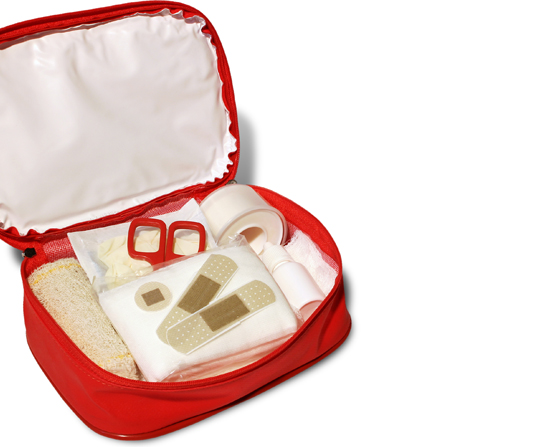Your First Aid Kit
May 3, 2022 Return

The Must-Haves
You should have items that can be used to treat minor injuries like burns, cuts, scrapes, stings, splinters, sprains and strains.
Firstly, get two clean unused re-sealable transparent plastic bags like the ones you use for your toiletries during flights. You can keep wound supplies in one bag and medications in the other.
Your first aid kit should have the following items for a family of four:
Bag 1 (wound supplies)
- 2 absorbent compress dressings
- 10 antiseptic plaster containing povidone-iodine ointment
- 1 adhesive cloth tape (10 yards x 1 inch/9 m x 3 cm)
- 1 tube antiseptic ointment containing povidone-iodine (10 g)
- 5 antiseptic wipe packets
- 1 bottle antiseptic skin cleanser containing povidone-iodine (60 ml)
- 1 instant cold compress
- 1 pair of large non-latex gloves
- Scissors
- 1 roller bandage (4 inches/10 cm wide)
- 5 sterile gauze pads (4 x 4 inches/10 x 10 cm)
- Oral thermometer (non-mercury/non-glass)
- 2 triangular bandages
- Tweezers
- Safety pins (large and small)
- First aid instruction booklet
Bag 2 (medications)
- 2 blister packs of paracetamol (500 mg each tablet)
- 1 tube deep heat rub (35.4 g)
- 1 bottle gargle and mouth wash containing povidone-iodine (100 ml)
- Oral antihistamines
- 1 tube hydrocortisone cream (15 g)
A good place to keep a first aid kit is in a dry space in your kitchen, as most injuries at home tend to take place in the kitchen. You can also keep a first aid kit along with torchlight in your car.
Kit for the Road
You need more items for your first aid kit when you travel especially when you are going to places where pharmacies are inaccessible. So, you should bring medications for sore throat, cough, cold, the flu, cuts, mild pain, stomach problems, skin ailments and allergies.
Try to keep your travel kit small and simple with multi-use items. Any nylon bags, personal kits or makeup cases will do. However, if you’re planning to travel a lot, a water-resistant and drop-proof container is the best option.
Tips
- Remember where you keep your first aid kits in your home, car and luggage.
- Make sure your loved ones know where the first aid kits are and how to use the items in the kits.
- Keep your first aid kits safe from young children.
- Check the kits regularly – replace used or out-of-date items and make sure the torchlight batteries work.
- Ask your doctor or pharmacist if you need help in selecting items for your personalised first aid kits.
References: 1. American Red Cross. Available at www.redcross.org 2. WebMD. Available at www.webmd.com
If you like this article, do subscribe here.
